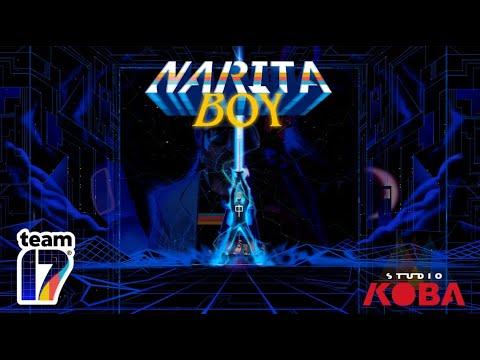I don’t know whether to love Narita Boy or hate it.
This is one of the most intensely creative games I have ever played. Every second, every detail of this game is bursting with new ideas. It has lovingly handcrafted character animation, and surreal, ephemeral electronic worlds worthy of the greatest sci-fi novels.
Narita Boy will have you lift your shining technosword aloft as you mount your majestic servo-horse across the plains of a desert simulation, trampling evil hordes of stallions beneath your feet as you go. It will have you ride your floppy-disk surfboard across an ocean of bytes and bits amid shoals of leaping robo-koi, and meditate on mountaintops of perpetual glitches.
This is a game that can only be described as a cyberilliad. It’s a story of an epic hero’s journey to save a civilization from a warped, destructive hive mind, while also being a story about how one man created a fantasy world to process his grief and overwhelming loss.
The story of Narita Boy will feed your imagination and touch the depths of your soul. The set pieces, art and animation will inspire you and make you dream of digital worlds beyond possibility. This is a triumph of the cyberpunk genre.
It’s nothing short of a tragedy that it’s not that fun to actually play.
Narita Boy is a Beautiful Game
Narita Boy is an action platformer made by Barcelona-based STUDIO KOBA and published by Team17.
This game is incredible to look at. It is absolutely bursting with visual creativity. It gives you so much to look at that you want to spend every minute examining every detail.
Each screen of the game has its own unique name e.g. the binary planes. Many of them contain their own unique set-piece, whether they’re pastures of electric sheep, or giant frogs with computer screens for faces.
If anything, it’s almost over-designed. The artists spent so much time on the background and environment art that you almost feel bad how little time you spend in some of them.
It’s almost comical how entire religious sects in this world will worship a giant computer priest who bathes you in a blue beam of light as a modulated chorus of cyberangels escalates in the background just to give you a single piece of a code to enter into a door to the next room.
Speaking of choruses, it doesn’t just look pretty. Narita Boy sounds amazing too. This game is an earfuck.
The soundtrack and sound effects are a mix of Daft Punk and Kraftwerk. It wears its 1980s retro-futurist aesthetic proudly on its sleeve, with synthesizers, chip-tunes, and voice modulators galore. It’s exactly what a game with this kind of aesthetic should sound like.
There’s little touches too, for the enjoyment of the observant player.
Whenever Narita Boy encounters a shrine to talk to the Motherboard – the matriarch of the Digital Kingdom and your guide throughout the story, you clap your hands twice and bow. It’s a real Japanese custom people do at Shinto shrines. You toss a coin in the altar, clap twice, and bow to summon the spirits and make a wish. I’m enough of a nerd that I thought that was really neat.
Oh. And there’s a dog that barks in JavaScript NumString code. I thought that was pretty funny.
A Well-Told and Often Profound Story
Narita Boy is as heavy on the story element as it is on the art and sound.
A lot of the plot uses a lot of jargon and throws a lot of information at you very quickly. It’s often a little confusing to know where you’re supposed to go or what you’re supposed to do.
It throws a lot of names, terms and places at you all at once, and it can make it a little hard to get into the story at first. There are a lot of moments where you take the techno key to the Priest of the Motherboard and do blah blah blah and you’re just left scratching your head going “huh”?
You can tell that the devs put a lot of work into building the lore of this world, which is frustrating because for a good third of the game I only had a hazy idea of what the hell was going on.
On top of that, the dialogue is often apocryphal and a little stilted. You get the sense that something really important is happening, but you don’t really know what.
If you can manage to stomach through the initial adjustment period though, you’ll find Narita Boy pulling you in more and more.
I was expecting a lighthearted and whimsical romp out of Narita Boy, but the game is actually very melancholy and takes some very abrupt, very dark turns.
The world of the Digital Kingdom, the world the game takes place in and which you are meant to save, is permeated in loss and suffering. It feels like a setting moments after a horrific war crime took place.
You see grieving families. You see bodies crucified and strung up on the walls with their digitized, pixelated innards dripping out. You meet people looking for their husbands, their brothers, and their families.
You meet stable-masters who gouge out their face-screens and replace their sound receptors with loops of ambient music so they can’t see and hear the dying, rotting corpses of servo-horses around them. You see people playing the slaughter of their siblings in front of them on an infinite loop. It gets really, really heavy.
It’s not just empty shock value either. There is real meaning and depth to this game, both to its narrative and its overarching lore.
The meta-story of this game has you uncovering the memories of The Creator – the creator of the Digital Kingdom who is worshiped in this digital fantasyland as a god, to the extent that the citizens of the Digital Kingdom treat the lines of code he writes as holy scripture. It’s funny because in the “real world” of the Narita Boy universe, the Creator is a balding, aging, neckbeard computer programmer living in a run-down New York apartment.
As part of your mission to save the Digital Kingdom, you unlock the Creator’s memories after they’ve been stolen by HIM, the Big-Bad of the game.
You discover that the Creator’s life has not been a happy one. A lot of the more abstract, more surreal aspects of the Digital Kingdom make sense as you unlock each memory and discover that they’re allegories for the creator’s memories.
He created the Digital Kingdom as a way to process the loss of his mother as a child and the resulting disintegration of his family unit. He becomes so obsessed that his wife leaves him with his son, and eventually goes off the deep end and starts a personality cult. He couldn’t deal with the crushing realities of this world, so he made his own.
It’s poignant. It’s heartbreakingly sad. It gives Narita Boy a welcome – and much needed – layer of thematic depth.
Too Bad Narita Feels Awkward to Play and Gets Stale
Gameplay wise, Narita Boy is pretty standard metroidvania, action platformer fare. Get macguffin A, use it to unlock door B to area C, but not before slicing up a bunch of baddies in fight B-a.
The mechanics of this game don’t do the superb visual and audio design justice. Narita Boy’s gameplay is repetitive, stale, and often frustrating to play.
For one thing, the controls feel awkward. They feel…it’s hard to explain. It feels floaty and stiff at the same time.
That last statement probably needs some qualification. The jumping and platforming feel floaty, like Narita Boy moves too slowly or doesn’t jump high enough, or reacts just a split-second too slowly.
Platforming and navigating in Narita Boy feels like you’re sliding, or slipping on a banana peel. It makes platforming needlessly difficult.
It’s not just the platforming. While it feels floaty and slide-y in the air, Narita Boy feels clunky and stiff on the ground.
You know how Dead Cells is tight and responsive, and you always know exactly where your character is going to be at the push of a button? Well, Narita is the opposite of that. The hitboxes are off. You get hit frequently, even after dodging.
The final nail in the coffin for me happened when I encountered a game-breaking bug that made me rage-quit.
I made it all the way to the show-down the big-bad HIM before the game crashed and never worked properly again. Now, whenever I open up the game, it gets as far as the title card before it goes black and does nothing. I reached out to the support team a few times, and we’d play email tag a few times during which I updated my NVIDIA drivers and reinstalled the game multiple times, to no avail.
I looked on their Steam page’s support forums and it seems like it’s happened to a few other people. Finally I said “fuck this” and gave up in frustration.
Narita Boy is a Tragedy
Narita Boy has SO much going for it. It’s resoundingly creative, has a banging soundtrack, and is simply amazing to look at. I had to look past the boring and stodgy gameplay and backtracking exploration because I just wanted to see what crazy thing they were going to throw at me next.
The visual creativity and aesthetics are almost enough to carry the game on their own, but only just, and the game-breaking bug I encountered is both incredibly frustrating and really unfortunate. I was so invested in the story that I stomached through it for as long as I could, until the game literally wouldn’t allow me to.
For all of the things that are wrong with it, this game is worth a look and a buy anyway. I can’t promise you that you’ll enjoy playing Narita Boy. What I can promise you is that you will never, ever forget it.
Support the creators by buying Narita Boy on Steam for $24.99 or by following STUDIO KOBA and Team17 on Twitter.



One Comment